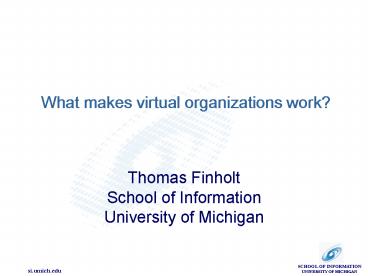What makes virtual organizations work - PowerPoint PPT Presentation
1 / 28
Title:
What makes virtual organizations work
Description:
Virtual radical collocation. SCHOOL OF INFORMATION. UNIVERSITY OF ... virtual radical collocation ... Benefits of collocation (e.g., realistic and ... – PowerPoint PPT presentation
Number of Views:79
Avg rating:3.0/5.0
Title: What makes virtual organizations work
1
What makes virtual organizations work?
- Thomas FinholtSchool of InformationUniversity
of Michigan
2
Outline
- The changing nature of geographically-distributed
collaboration - Lessons from the past
- Beyond being there A research program for
virtual organizations - Conclusion
3
1. The changing nature of geographically-distribut
ed collaboration
- Changes have a history (i.e., practices and
technology evolve) - These changes can be described in terms of
- Scale
- Theoretical orientation
- Technological paradigm
- Characteristic research questions
4
History
- In terms of distributed work we are at a
transition - Specifically, much of what came before had a
traditional antecedent - Collaboratory a laboratory without walls
- Video conferencing a long distance face-to-face
meeting - However much of what is emerging has no
precedent(e.g., crowdsourcing, virtual
organization)
5
(No Transcript)
6
2. Lessons from the past
- Collaboratory research at the University of
Michigan - Space physics (UARC and SPARC)
- Earthquake engineering (NEES)
- Science of Collaboratories (NSF ITR)
- Organized through the Collaboratory for Research
on Electronic Work (CREW) - Founded in 1997
- Dozens of faculty, staff and students
Available November 2008 from MIT Press
7
Anticipate cultural differences
8
Domain scientists
- Power distance
- Hierarchical
- Bias toward seniority
- Individualist
- individual genius
- Solo PI model
- Masculine
- Adversarial
- Competitive
- Uncertainty avoidance
- Highly skeptical of new technologies
- Extremely risk averse
9
CI developers
- Power distance
- Egalitarian
- Bias toward talent
- Collectivist
- Use the Internet to create worldwide communities
- Project model
- Masculine
- Adversarial
- Competitive
- Uncertainty avoidance
- Extremely open to new technologies
- Extremely risk seeking
10
Plan for first contact
11
(No Transcript)
12
Communicate
13
(No Transcript)
14
Seek common ground
15
(No Transcript)
16
3. Beyond being there A research program for
virtual organizations
- NSF workshop on virtual organizations
- September 2007
- 42 invited participants
- Technical
- Social science
- Building Effective Virtual Organizations
- January 2008
- 200 participants
- Virtual Organizations as Socio-technical Systems
- NSF program run by the Office of
Cyberinfrastructure - Awards made summer 2008
http//www.ci.uchicago.edu/events/VirtOrg2008/VO_r
eport.pdf
17
It can be tough to recognize successful
innovations
- First efforts are often awkward hybrids
- It is hard to know where the seeds of greatness
might lie...
Charles Kings horseless carriage (1896)
Detroit, Michigan
Source American Automobile Manufacturers
Association, http//www.automuseum.com/carhistory.
html
18
Virtual radical collocation
19
(No Transcript)
20
Unique aspects of virtual radical collocation
- Create advantages of physical proximity at a
distance - Peripheral participation
- Add new capabilities
- Multi-megapixel visualization
- Therefore
- Benefits of collocation (e.g., realistic and
natural communication) - Benefits of dispersion (e.g., access to data and
expertise not available locally)
21
Crowdsourcing
22
(No Transcript)
23
Unique aspects of crowdsourcing
- We dont know who is going to do the work
- Effort is contributed voluntarily
- Therefore
- Signaling (i.e., of task content) is important in
order to attract the right kind of workers - Incentives are important in order to motivate
workers (i.e., what is gained by doing the work)
24
Delegation of organizational work
25
MEDICUS Project (federated medical images)
http//dev.globus.org/wiki/Incubator/MEDICUS
26
(No Transcript)
27
Unique aspects of delegating organizational work
- Much of the attention in virtual work has focused
on technology and process to support social ties - An alternative course is the use of technology to
supplant social ties - Therefore
- Think of this as organizing without the work of
organizing - Questions of who to trust, who is permitted to
use resources, who pays -- are managed by
middleware
28
4. Conclusion
- Group work is an inevitable fact of
organizational life so the earlier lessons
continue to apply - What has changed is that geographically-distribute
d work now encompasses a broader continuum of
activities, from intensive team projects to
crowdsourcing - Emerging modes of contribution and participation
are not as amenable to intentional technology
choice or organizational design - Full exploitation of emerging paradigms will
require - More research on choice architecture and the
design of incentives - More research on mechanisms for delegating
aspects of organizational work to systems, such
as trust relationships































